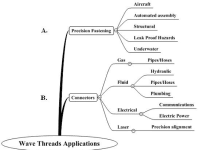
I made a discovery in the mechanics and surfaces of connections that will make threaded parts stronger, more durable and safer. While the details are in the “Basic Principals of the Wave Thread” article at www.wavethread.com, the basic concept of the wave thread is a collection of circles. That tornado shape in the first picture are circles accumulatively changing in size and location. Intensify this and you get the threads on those bolts and pipe shown.
Optimize these variables and you get the even stress distribution graph in the second picture that increases the tensile strength 20%-30%.depending on materials. Threads have been thoroughly engineered over the past 100 years, these was not included.
The male – female engagement is total surface contact that yields inherent advantages:
It creates a seal or more accurately prevents a lead path. This keeps out water and corrosion. It conducts heat efficiently, important for high pressure and temperature pipe applications.
It inhibits vibrational loosening and cycling fatigue. The male/female parts can not move, their surfaces are locked together.
Two other inherent advantages are
Quick connect: It takes fewer rotations to fully engage.
It Can not be over tightened: the next threshold is to break the bolt. This is the bane of bolted assemblies: over tightening causes hidden damage and weakens the connection.
In the first destructive tests the wave threaded bolt pulled the bolt heads off at 16.7% over the standard bolts failure. A wave threaded shaft with wave nut on each end should exceed 20%.
The wave thread limitation is a fixed clamp length and many applications are a specific length.
Threaded fasteners hold our world together. Making them stronger, more resistance to cycling fatigue, and protecting them from corrosion will extend their useful life. Applied to pipes add conducting heat more efficiently and you reduce the cycling stresses. Pipes would be quicker connecting with stronger hold.
Machining the complex surface of the wave thread will be more expensive, but molding will be the same costs. Currently, a library of standard and wave threaded nuts and bolts is being prepared for the 3D printer market. This is an effort to inexpensively get the wave thread into the hands of scientist, engineers, entrepreneurs and anyone who wants to play with. This library will be all 57 UNC nuts and bolts sizes. UNC are 90% of the bolts used.
The physics of the wave thread geometry allow other types of applications:
Containers: Quick connecting, eliminates the separate seal reducing waste.
Valves: combines the valve seat and control thread
Electrical connections: creating a seal keeps out corrosion, high surface contacts
Electronic and photonic connections: precise position alignment for thousands of connection at once that are sealed and hard to pull apart.
The last picture has a diagram map of the potential markets.
This is a lot to claim about a geometry. I have developed software to engineer the threads and apply them to fasteners and pipes. They will be applied and tested in a variety of products.
Video
-
Awards
-
 2013 Top 100 Entries
2013 Top 100 Entries
Like this entry?
-
About the Entrant
- Name:Dale Van Cor
- Type of entry:individual
- Software used for this entry:Custom developed by me
- Patent status:pending








